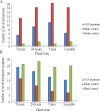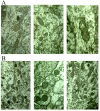Therapeutic effect of nerve growth factor on canine cerebral infarction evaluated by MRI
- PMID: 29423079
- PMCID: PMC5790496
- DOI: 10.18632/oncotarget.23345
Therapeutic effect of nerve growth factor on canine cerebral infarction evaluated by MRI
Abstract
To explore therapeutic effect of nerve growth factor (NGF) on cerebral infarction by establishing canine middle cerebral artery occlusion (MCAO) infarct model. The magnetic resonance imaging (MRI) technology was used to study effects of NGF on cerebral infarction, and the results of MRI indexes (such as diffusion-weighted imaging (DWI) and perfusion-weighted imaging (PWI)) were compared with the results of pathology, cell biology and molecular biology. The clinical manifestations of the canine infarction model treated by NGF were significantly improved within 7 days compared with control group. The therapeutic evaluation of NGF effect could be determine by canine cerebral infarction treated by NGF within 6 hours according to DWI and PWI. From 6 hours to 7 days, therapeutic evaluation of NGF could be determine by T1WI, T2WI and FLAIR. DWI and PWI could find the change of cerebral ischemia at the early stage, provide advantages for qualitative diagnosis of early-stage cerebral infarction and observation of efficacy in early treatment, initially showing that their great potential for NGF role on cerebral ischemia and mechanism.
Keywords: canine middle cerebral artery occlusion; diffusion-weighted imaging; magnetic resonance imaging; nerve growth factor; perfusion-weighted imaging.
Conflict of interest statement
CONFLICTS OF INTEREST The authors report no relationships that could be construed as a conflict of interest.
Figures





Similar articles
-
Multimodal magnetic resonance imaging for assessing lacunar infarction after proximal middle cerebral artery occlusion in a canine model.Chin Med J (Engl). 2013 Jan;126(2):311-7. Chin Med J (Engl). 2013. PMID: 23324283
-
Neuroprotective effect of agmatine in rats with transient cerebral ischemia using MR imaging and histopathologic evaluation.Magn Reson Imaging. 2013 Sep;31(7):1174-81. doi: 10.1016/j.mri.2013.03.026. Epub 2013 May 1. Magn Reson Imaging. 2013. PMID: 23642800
-
SB 234551 selective ET(A) receptor antagonism: perfusion/diffusion MRI used to define treatable stroke model, time to treatment and mechanism of protection.Exp Neurol. 2008 Jul;212(1):53-62. doi: 10.1016/j.expneurol.2008.03.011. Epub 2008 Mar 25. Exp Neurol. 2008. PMID: 18462720
-
Do acute diffusion- and perfusion-weighted MRI lesions identify final infarct volume in ischemic stroke?Stroke. 2006 Jan;37(1):98-104. doi: 10.1161/01.STR.0000195197.66606.bb. Epub 2005 Dec 1. Stroke. 2006. PMID: 16322499
-
[Application of diffusion-weighted and perfusion magnetic resonance imaging in definition of the ischemic penumbra in hyperacute cerebral infarction].Zhonghua Yi Xue Za Zhi. 2003 Jun 10;83(11):952-7. Zhonghua Yi Xue Za Zhi. 2003. PMID: 12899795 Chinese.
References
-
- Wang Z, Xia Y, Zhao Y, Chen L, Zhu Y. Intestinal gutsfeature and role of apoE and glucose metabolism in cerebral infarction patients. Int J Clin Exp Pathol. 2017;10:561–565.
-
- Cuello AC. Nerve Growth Factor. Encyclopedia of Psychopharmacology. 2015:1–9.
-
- Zhao HM, Liu XF, Mao XW, Chen CF. Intranasal delivery of nerve growth factor to protect the central nervous system against acute cerebral infarction. Chin Med Sci J. 2004;19:257–261. - PubMed
LinkOut - more resources
Full Text Sources
Other Literature Sources

